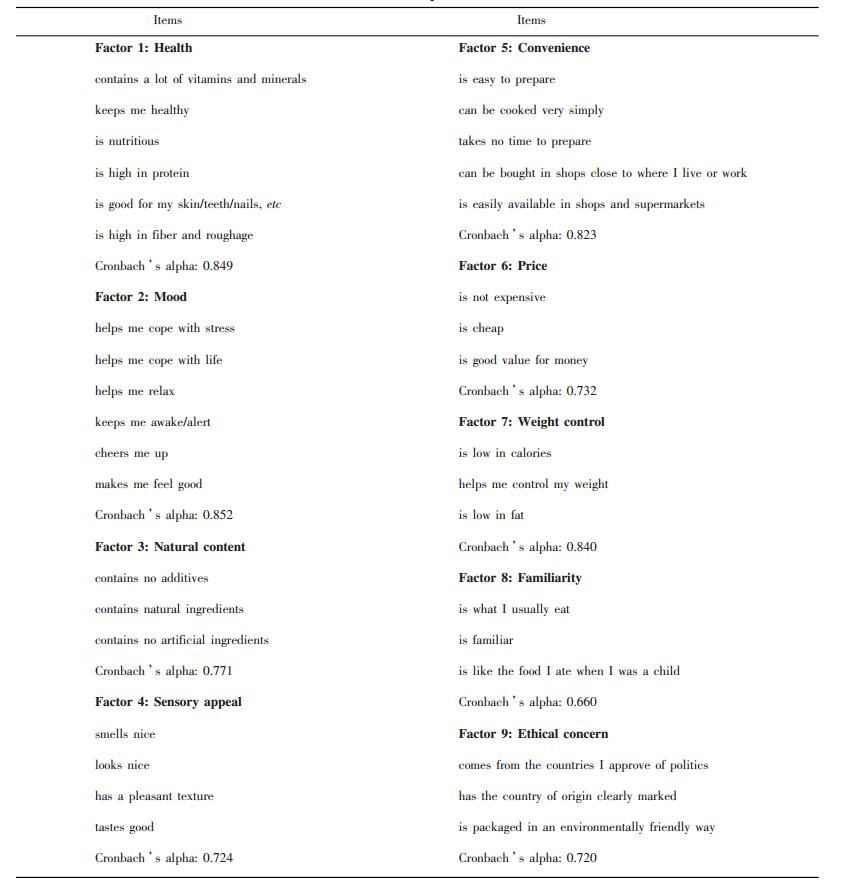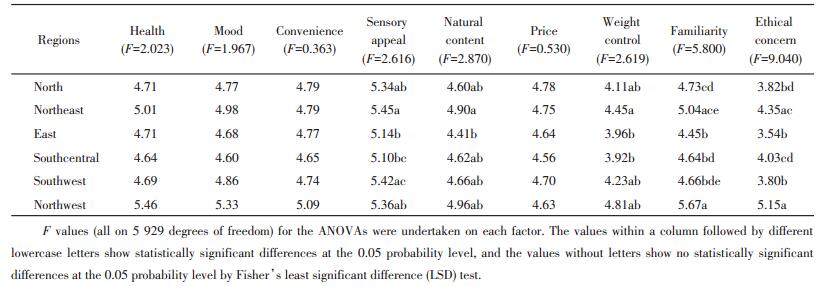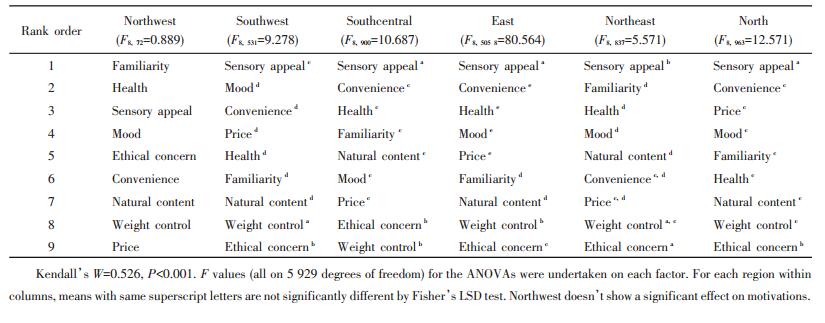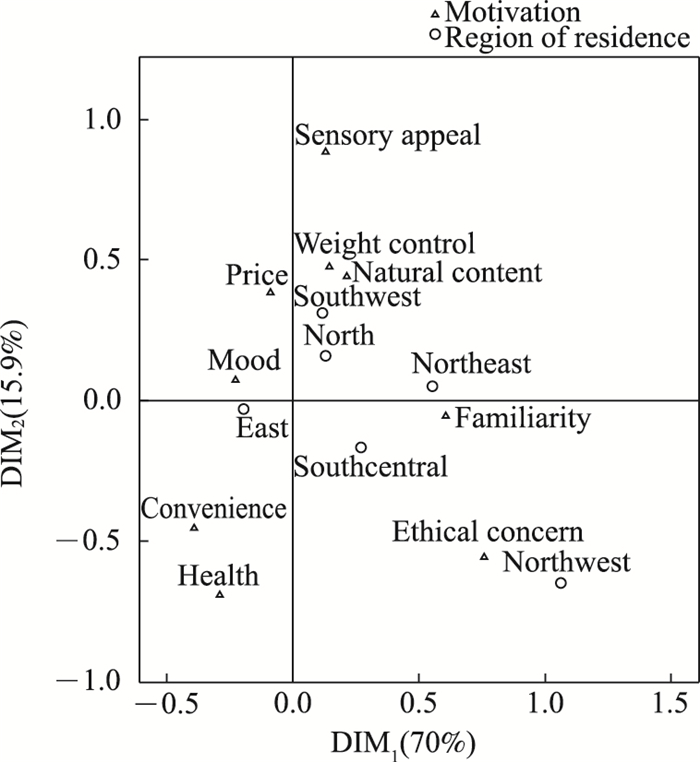| Understanding motives for food choice of Chinese young people in mainland China |
2. School of Life Sciences, Fudan University, Shanghai 200438, China
2. 复旦大学生命科学学院, 上海 200438
Food consumers'dietary patterns are not only determined by sensory appeal of various foods, but also affected by socio-cultural and their physiological conditions. Thus food motives of consumers located in different geographic areas may play an important role for food consumers making choices, and may contribute in prevalence of different dietary-related diseases. It was lacked a systematic protocol to measure consumers'food motives until STEPTOE et al.[1] first developed the food choice questionnaire (FCQ). Nine factors that underlie people's food choice are identified and included in FCQ: health, convenience, price, sensory appeal, mood, natural content, weight control, familiarity and ethical concern. Since its introduction, FCQ has been widely adopted to investigate motives for food choice of different populations at a cross-national or country level[2-4].
However, most of previous studies focused on households, which actually lack a specific investigation of young people's motives for food choice. Recently a study has showed that the ages ranged from 17 to 22 years positively correlate with the prevalence of overweight. It is also indicated that other factors like economic development and geographic areas contribute to the increasing body mass index (BMI) and distinct variation, respectively[5]. Meanwhile, as the incidence of young-onset type 2 diabetes mellitus (T2DM) is increasing[6], it is necessary to apply early behavioral interventions in Chinese young people with potential risk of T2DM. Therefore, understanding current motives for food choice of Chinese young people distributed in different geographic areas offers a new angle of view for studying development of early-onset dietary-related diseases and developing further behavioral interventions.
On the other side, although correlations of sociodemographic factors and motives for food choice are reported broadly across countries, whether cultural backgrounds, physiological conditions and parent affected the motives for food choice are less studied. It is previously reported that parent-child interaction may have effects on children's future susceptibility of obesity[7]. Meanwhile, another study suggests that parents' food motives are associated with their children's eating patterns[8]. But whether this effect will last for young adult period and continues influencing their food choice remains unknown. From the aspect of physiological factors, stressful conditions in which subjects accompanied with increasing blood pressure and mood changes are proved to alter subjects'food choice[9]. Although this study suggested physiological changes with variations of food choice, whether other physiological factors and health conditions can have impacts on motives for food choice remains to be studied.
In this study, we aimed to understand Chinese young people's motives for food choice based on geographic, socio-cultural and physiological dimensions. This study may offer an indication of attitudes towards healthy eating and hints for future behavioral interventions of dietary-related diseases targeting Chinese young people.
1 Materials and methods 1.1 Subjects and procedureThe research data were yielded from a sample of 935 Chinese young people distributed in six administrative divisions in mainland China: North China (North), Northeast China (Northeast), East China (East), South Central China (Southcentral), Southwest China (Southwest) and Northwest China (Northwest). The data were collected by three members in our team from October to November in 2015. Nine hundred and sixty-four respondents were involved in this study. Two hundred and seventy-two questionnaires of all were collected based on papers, and others were electronic by platform Sojump (http://www.sojump.com). According to the selected criteria of possessing gender, age, region of residence and/or ethnicity, 29 questionnaires were abolished due to insufficient information shown above. The remaining 935 respondents were included for further analysis. Overall, the respondents'mean age was 20.63 years (standard deviation 3.45), mainly ranging from 17 to 30 years. The younger group with the age of no more than 20 years contributes 63.9%. The percentage of male is 49.5%. The percentage of Han is 93.8%, and the percentage of minority is 6.2% among 935 respondents in total. The percentages distributed in four categories from underweight to overweight of BMI are 26.3%, 47.7%, 13.8% and 12.2% among 935 respondents. Seventy-eight respondents were measured by two team members according to World Health Organization (WHO) standard protocol[10]. Fifty-eight of them are in normal waist-hip ratio, while others exceed the cut-off points.
1.2 InstrumentFCQ used in this study was adapted from the original version published by STEPTOE et al[1]. A 1-7 scale was used to replace the original, four alternative category scales in order to offer a neutral choice. The participants were asked to evaluate food consumed on a typical day on the scale ranges as follows: not important at all (1), unimportant (2), slightly unimportant (3), neither unimportant nor important (4), slightly important (5), important (6), and extremely important (7). The reasons for the replacement are in order to increase options for respondents and take into account a neutral point to avoid a forced preference[11]. Reliability analysis was adopted to assess the questionnaire. As presented in Table 1, the Cronbach's alpha varies from 0.660 to 0.852, which indicates a moderate to high reliability of the FCQ used in this study. Also, Kaiser-Meyer-Olkin (KMO) and Bartlett's tests suggest a high validity of FCQ used in this study (KMO=0.932, P < 0.001).
| Table 1 Food choice questionnaire items |
 |
| 点击放大 |
The FCQ was consisted of socio-demographic profile, physiological factors with a 36-item questionnaire (Table 1). Physiological factors included self-reported body mass and height to calculate body mass index (BMI), waist and hip circumferences measured according to the Chinese cut-off points published by CHEN[12], as well as self-reported health conditions, self-reported family cooking health conditions. Dietary-related diseases included T2DM, obesity, cardiovascular diseases, stroke, metabolic syndrome and breast cancer. Respondents with the age of no more than 20 years were grouped as the younger group, and others were in the older group. Monthly expenses were classified in three categories, less than 1 000 Chinese Yuan (CNY), 1 000 to 2 000 CNY, and more than 2 000 CNY.
In the study, FCQ was translated into Chinese by a qualified translator, and the Chinese version was translated back into English by another qualified translator. We compared the translated draft to the original English version in order to test the accuracy and clarity of words. Finally, a revised Chinese FCQ was used for the study.
1.3 Data analysisReliability analysis was adopted to assess the internal consistency of the various constructs of FCQ, and Cronbach's alpha coefficients were set as the parameter to describe the reliability of FCQ (Table 1). Also, KMO and Bartlett's tests were carried out to assess the validity of FCQ. Analysis of variance (ANOVA) was used to analyze the data with sociodemographic and physiological data as factors. Age for each region of residence was grouped with criteria of up to 20 years of age, and over 20 years of age. The BMI was grouped as underweight, normal weight, overweight and obesity according to the Chinese cut-off points published by CHEN[12], so was waist-hip ratio (WHR)[12]. Canonical discriminant analysis was adopted to analyze the underlying dimensions on which the region of residence differed and the relationship of these dimensions to the motives for food choice. Kendall's W was used to compare the agreement of rank order across each region of residence. Finally, a two⁃stage cluster analysis was conducted to discriminate consumers by groups according to their relative motive ranks referred to an advantage-combined method[13]. First, hierarchical cluster analysis was conducted to profile different numbers of clusters' centroids. Second, K-means analysis was used to determine the final membership of each cluster based on the centroids from the hierarchical cluster analysis as initial seed points. Duncan's and Scheffe's post-hoc ANOVA tests, Pearson 's correlation were employed to select the optimal scenario among 3-7 clusters. All statistical analyses were conducted by SPSS 22.0.
2 Results 2.1 Region of residenceAs shown in Table 2, there were main effects of region of residence on sensory appeal, natural content, weight control, familiarity and ethical concern. Food consumers from East and South Central China rated sensory appeal and weight control slightly lower than people elsewhere. Natural content was rated higher by the consumers from Northeast and Northwest. Notably, food consumers from Northwest had a more positive rating for both familiarity and ethical concern, while in other regions the ratings were basically neutral.
| Table 2 Mean ratings of the importance of each motive by consumers in each of the six regions of residence |
 |
| 点击放大 |
However, the comparison among regions of residence neglected the relative importance of each motive within each region of residence. For example, although ethical concern was substantially different among regions of residence, it may be ranked as least important factor within most regions of residence. In order to compare the difference and agreement of each region of residence, the data were re-analyzed by ANOVA. Table 3 shows the rank order of nine motives for each region of residence. The degree of agreement across regions in relative importance was analyzed using Kendall's coefficient of concordance. It was indicated significant agreement among regions (Kendall's W=0.526, P < 0.001). Sensory appeal was rated as the most important factor among different regions except Northwest. Ethical concern was rated least important by the regions except Northwest and Southcentral. Weight control was rated as the least important factor by consumers from Southcentral. All combined comparisons indicated that a cross-cultural difference existed among different regions.
| Table 3 Rank order from most to least important factors for each region of residences by Kendall's W test |
 |
| 点击放大 |
The similarities and differences of each region of residence are summed up in Fig. 1. It showed the plot of the first two dimensions from the canonical discriminant analysis, which together accounted for 85.9% variance. Ethical concern had the largest loading on the first axis (70%), which was in agreement with the large significant differences between each region of residence shown in Table 3. Familiarity also had a moderate loading on this axis. Southwest and North were grouped closely together and clearly distinct from other four regions. On the other dimension (15.9%), sensory appeal had the strongest loading on this axis. Northwest was separated from the other five regions in this axis which was consistent with the differences evident from the rank order of motives.
 |
| This map shows the food choice factors and the regions of residence based on the first two dimensions, which together accounts for variance. Fig. 1 Canonical discriminant analysis |
Gender was found to be significantly influencing health (P < 0.01), sensory appeal (P < 0.01), natural content (P < 0.001), weight control (P < 0.001) and ethical concern (P < 0.05) with a higher rating of women. Young people's marital status also had main effects on health, convenience, natural content, familiarity and ethical concern with a common higher rating of married people (P < 0.05). The minority rated health and ethical concern much higher than the Han (P < 0.05). People who had a higher educational level tended to rate natural content (P < 0.05) higher than others. Monthly expenses played a role in choosing foods for natural content (P < 0.05), price (P < 0.01). Notably, our data showed a decreased rating of natural content with increasing monthly expenses. Although age was shown to affect health (P < 0.05), the ratings were neutral in some extent which suggest even older people didn't regard health as an important motive.
2.3 Physiological factorsIntriguingly, body indices such as BMI, waist-hip ratio didn't show any independent effects on motives in our study. Whether consumers are currently in a health condition or not, even including conditions of high dietary-related diseases, didn't affect the motives, the same as the childhood-cook health conditions.
2.4 Interaction valuesBoth older male and female consumers rated health (F=8.383, P < 0.001), sensory appeal (F=3.421, P < 0.05), natural content (F=6.794, P < 0.001) and weight control (F=17.557, P < 0.001) as more important than the younger group.
In East China, consumers with high monthly expenses tended to rate ethical concern (F=3.41, P < 0.001) more important than the group with low monthly expenses. However, the opposite situation happened in the Northeast group.
2.5 Cluster analysisAfter the initial implementation of hierarchical cluster analysis (HCA) with the option of identifying 3-7 clusters, the K-means clustering procedures were followed on the HCA's centroids for each of the 4-7 clusters'scenarios. The five-cluster scenarios were finally selected as the one with the highest number of statistically significant motives for food choice discriminating the five clusters in pair-wised comparisons, as well as the highest correlation between HCA and Kmeans cluster membership variables (Table 4).
| Table 4 Process of the hierarchical cluster analysis for scenarios of 4-7 clusters |
 |
| 点击放大 |
Table 5 shows the results of cluster analysis. Cluster 1, compared to other groups, placed less emphasis on each motive, indicating that their interests in food were weak. Thus they are labeled as unconcerned food consumers. Cluster 2, compared to other groups, placed more emphasis on convenience and price, but less cared about familiarity. Although sensory appeal still played the most important role in making decisions, they can be labeled purchase convenience. Health, weight control and natural content were ranked relatively more important than any other clusters in cluster 3. Thus cluster 3 is labeled health-oriented. Cluster 4, in contrast to other clusters, consumers concerned more on sensory appeal, mood and less on health. Therefore, this cluster is basically motivated by mood, so it can be labeled mood-oriented. Cluster 5 recorded sensory appeal above the mean score with relative higher ratings of mood and health. Thus, consumers in this cluster are generally regarded as food enthusiasts.
| Table 5 Average motive scores by cluster |
 |
| 点击放大 |
Our results clearly show the similarities and differences among regions of residence. Basically, young people from five main regions were in agreement with ranking sensory appeal, convenience, health as the three most important motives for food choice. It is consistent with previous studies that focused on ethnic Chinese consumers in Chinese Taiwan and Malaysia[4]. Although weight control, natural content didn't show any consistency, it was also reported by other studies that generally younger people ranked sensory appeal more important with a carelessness of weight control in contrast to the older people[14-15]. Ethical concern was rated as least important motive by young people from five regions. This phenomenon was also found in New Zealand, Malaysia and Chinese Taiwan[4]. This not only may reflect young people's attitudes towards ethical reasons, but also may due to lack details to explain and enrich items of ethical concern. LINDEMAN et al.[16] claimed that a uniform construct was not necessarily tapped by both political values and a concern for environmental welfare; meanwhile, motives on animal welfare should be included with increasing number of vegetarians. Of note, young people from Northwest seemed to differ from others. Although the special environmental and cultural backgrounds could be considered, it is not so convincing due to the limited sample size. On the other hand, strong agreement of rank orders among regions of residence implicates that the weak geographic and cultural values are affecting young people's motives for food choice.
Another interpretation of the rank order among regions of residence is, whether a motive is important or not is usually inconspicuous. For example, young people from East rated sensory appeal as an important motive, while natural content was unimportant, representing that sensory appeal was regarded as much more important than natural content in some extent. However, this can also happen for natural content over sensory appeal. Therefore, the result doesn't represent an actual decision process. If the price of a food product is more expensive than normal foods, consumer may consider price as the primary factor that affecting their food choice.
Intriguingly, there were not main independent effects of physiological factors like BMI, WHR and health conditions on motives for food choice in our study. Other studies indicated that the motives were changed when an emotional or stressful response occurred, due to an acute response condition [9, 17]. While under a chronic condition, the changes of motives have not been reported before. This suggests that young people under an overweight or obesity condition may not regard it as a serious health problem. Moreover, it was indicated that physiological effects on food choice were more related to emotional changes and acute responses but not long-term health conditions. As the data were mostly self-reported, the current drug-intake conditions that people may keep their previous diets can't be excluded. The health conditions of childhood cooks didn't have any independent effects on further children's food choice as well. Meanwhile, no significant interaction values of physiological factors and socio-economic factors were observed. It was implied that the alteration of physiological factors did not contribute to changes of motives for food choice.
The rating values in our study were most around four which were a neutral choice. This is mainly because Asian consumers tend to use middle values of the nine⁃point hedonic scale, in contrast to Americans who use extremes more often[18].
4 ConclusionsIn conclusion, our study shows a comparison and agreement degree of Chinese young people's motives for food choice at an administrative division level in mainland China. The independent effects of socioeconomic factors offer a pattern of young people's food choice. Ethical concern is rated least important, while sensory appeal, convenience and health are three most important motives ranked by people from Southwest, Southcentral, East, Northeast and North China. However, no significant independent and interacting effects of physiological factors including BMI, WHR, self, caregivers'health conditions and dietary-related diseases are observed in our study. It may suggest that alteration of above physiological factors doesn't contribute to the changes of motives for food choice. Present cluster analysis shows that 39.3% of young people are basically health-oriented food consumers. The results may provide hints for further behavioral interventions to control the prevalence of early-onset dietary-related diseases.
Acknowledgements: We wish to thank WANG Haiming from Zhejiang University for statistical advice. We also wish to thank Professor Mark WAHLQVIST to contact researchers for communication and advice.| [1] |
STEPTOE A, POLLARD T M, WARDLE J. Development of a measure of the motives underlying the selection of food: The food choice questionnaire.
Appetite, 1995,25 (3):267–284. DOI: 10.1006/appe.1995.0061. |
| [2] |
EERTMANS A, VICTOIR A, NOTELAERS G, et al. The food choice questionnaire: Factorial invariant over western urban populations?.
Food Quality & Preference, 2006,17 (5):344–352. |
| [3] |
MARKOVINA J, STEWART-KNOX B J, RANKIN A, et al. Food4Me study: Validity and reliability of food choice questionnaire in 9 European countries.
Food Quality & Preference, 2015,45 :26–32. |
| [4] |
PRESCOTT J, YOUNG O, O'NEILL L, et al. Motives for food choice: A comparison of consumers from Japan, Chinese Taiwan, Malaysia and New Zealand.
Food Quality & Preference, 2002,13 (7/8):489–495. |
| [5] |
WAN Y, JIANG X, HE Y N, et al. Body mass index of young men in China: Results from four national surveys conducted between 1955 and 2012.
Medicine, 2016,95 (6):e2829. DOI: 10.1097/MD.0000000000002829. |
| [6] |
YU H, XIE L F, CHEN K, et al. Initiating characteristics of earlyonset type 2 diabetes mellitus in Chinese patients.
Chinese Medical Journal (English), 2016,129 (7):778–784. DOI: 10.4103/0366-6999.178959. |
| [7] |
ANDERSON S E, KEIM S A. Parent-child interaction, selfregulation, and obesity prevention in early childhood.
Current Obesity Reports, 2016,5 (2):192–200. DOI: 10.1007/s13679-016-0208-9. |
| [8] |
OELLINGRATH I M, HERSLETH M, SVENDSEN M V. Association between parental motives for food choice and eating patterns of 12-to 13-year-old Norwegian children.
Public Health Nutrition, 2013,16 (11):2023–2031. DOI: 10.1017/S1368980012004430. |
| [9] |
OLIVER G, WARDLE J, GIBSON E L. Stress and food choice: A laboratory study.
Psychosomatic Medicine, 2000,62 (6):853–865. DOI: 10.1097/00006842-200011000-00016. |
| [10] |
NISHIDA C, KO G T, KUMANYIKA S. Body fat distribution and noncommunicable diseases in populations: Overview of the 2008 WHO Expert Consultation on Waist Circumference and Waist-Hip Ratio.
European Journal of Clinical Nutrition, 2010,64 (1):2–5. DOI: 10.1038/ejcn.2009.139. |
| [11] |
MARTINS Y, PLINER P. The development of the food motivation scale.
Appetite, 1998,30 (1):94. DOI: 10.1006/appe.1997.0127. |
| [12] |
CHEN C M. Overview of obesity in mainland China.
Obesity Reviews, 2008,9 (Suppl. 1):14–21. |
| [13] |
MILLIGAN G W, COOPER M C. An examination of procedures for determining the number of clusters in a data set.
Psychometrika, 1985,50 (2):159–179. DOI: 10.1007/BF02294245. |
| [14] |
FOTOPOULOS C, KRYSTALLIS A, VASSALLO M, et al. Food choice questionnaire (FCQ) revisited.
Suggestions for the development of an enhanced general food motivation model. Appetite, 2009,52 (1):199–208. |
| [15] |
MILOSEVIC J, ZEZELJ I, GORTON M, et al. Understanding the motives for food choice in Western Balkan Countries.
Appetite, 2012,58 (1):205–214. DOI: 10.1016/j.appet.2011.09.012. |
| [16] |
LINDEMAN M, VAANANEN M. Measurement of ethical food choice motives.
Appetite, 2000,34 (1):55–59. DOI: 10.1006/appe.1999.0293. |
| [17] |
GIBSON E L. Emotional influences on food choice: Sensory, physiological and psychological pathways.
Physiology & Behavior, 2006,89 (1):53–61. |
| [18] |
YEH L L, KIM K O, CHOMPREEDA P, et al. Comparison in use of the 9?point hedonic scale between Americans, Chinese, Koreans, and Thai.
Food Quality & Preference, 1998,9 (6):413–419. |
 2017, Vol.
2017, Vol. 


